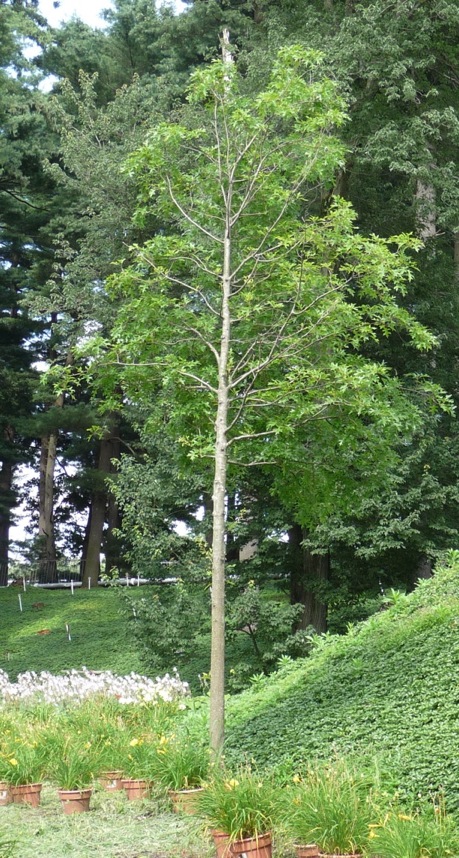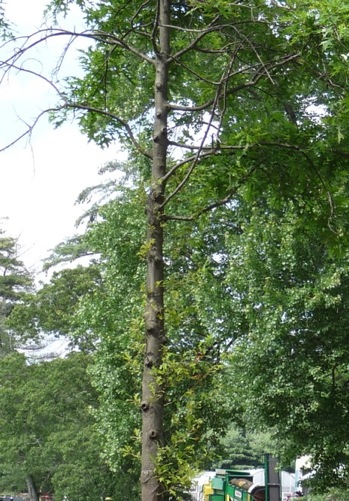To continue the story from the previous post (check out the photos on that one):
Wednesday, I had to visit Cavicchio’s Greenhouses to tag a tree. Carl and I arranged to meet there, and Carl called to see if Jake Cavicchio could meet us at the little pin oak. We bumped down a back road to the base of a slope, and recognized the tree immediately. It had some deadwood, but had leafed out nicely and seemed to be growing well.
Jake remarked on the deadwood — he said that it had all been there last year, and that this year no more seemed to have developed.
The day after the root-washing, Cavicchio’s had planted in three other pin oaks, similarly root-bound, in the same area. Those three were planted conventionally, their root balls holding the same red clay that had been washed out of the first tree.
The most noticeable difference between the first, root-washed tree and its companions was that the three conventionally planted trees were showing signs of current stress, while the first tree looked fine. Each of the three other trees had foliage sprouting from its trunk, a symptom of stress and an indication that the tree is trying to counteract decline. On the other hand, each of the trees also had similar top growth to the first tree.
It is probably too early to tell what the future will hold for any of these trees — regardless of planting method, the fact that all the trees are now planted out boosts the possibility that they will survive. It seems entirely likely, though, that the tree whose roots were freed from the dense clay soil ball will now encounter less struggle to reestablish a vigorous root system, and that reduced stress for it will mean a healthier prognosis than for the other trees. Take a look at these photos.

Jake Cavicchio and Carl Cathcart with the root-washed pin oak planted last October

Jake Cavicchio with the pin oak he root-washed

Well-structured root flare, at the right grade

Conventionally planted pin oak, planted at the same time as the first tree, showing signs of stress

Adventitious buds along the trunk have leafed out, indicating that this conventionally planted oak (which had been balled and burlapped for two years and was unsaleable) is under stress
Owner: Cavicchio’s Greenhouses, Inc., Sudbury, MA
Arborist: Carl Cathcart, MCA
Tree mover: Jake Cavicchio
Scale figures: Carl Cathcart, Jake Cavicchio
So, my arborist friend, I have some conjectures about why washing is effective, but I’m not sure I’ve got the whole thing down. Here’s what I think I know. Please correct, refine, expand . . .
1. Washing doesn’t offer the full benefits of bare-root transplanting, because the washed-root tree has been dug and balled conventionally, with only a fraction of its root system intact.
2. However, washing can be a useful way of improving the health and survival rate of balled-and-burlapped (B&B) trees. My question: Is it better for all B&B trees, or just those whose soil and/or roots need to be corrected due to growing conditions or lengthy storage?
3. One threat to transplanted trees is a mismatch between the soil in the root ball and the surrounding soil where it’s planted. Depending on the specific differences in the soils and the configuration of the interface (the root ball can be scarified, for example, to better weave the soils together), the mismatch can restrict the movement of water and the growth of the roots, stunting or drowning the tree. (Are there also cases where it can result in dessicating the root ball?) Removing the root ball’s soil prevents this.
4. As the article points out, exposing the root system allows for corrective pruning of roots whose continued growth could damage the plant, probably including but not limited to girdling roots.
That’s what I’ve got. What am I missing?
Ooh, boy, good questions. As best as I’m able, here are some answers:
1. Root-washing in this case was performed on B&B trees. I have heard that a tree-equipment company is going to be promoting one of its vacuum tools for root-washing trees; I need to check and find out if that includes nursery-grown but not yet dug trees. Stay tuned.
2. Root-washing is an excellent approach for improving the health and survival rate of any B&B or container-grown tree. One reason is embedded in your third question:
3. The interface between two types of soils can be a barrier that restricts moisture movement and so, as you say, inhibits root growth. Bare-rooting a tree, whether it is with air or with water, allows the root mass to be planted in native soil, or with soil that has been amended in an area larger than the root mass itself, and so allows it to grow without that inhibition.
4. Exactamento. When you bare-root a tree, you have a better chance of correcting root problems (depending, of course, on the size, importance, location, and configuration of a root in question).
Thanks for asking those questions and giving this post more clarity. Jim Flott, or Carl Cathcart, or Mike Furgal, or Matt Foti, if you’re reading this, feel free to chime in with clearer information — just write a comment in the box and push the Submit Comment button so the rest of us can read it and learn…
[…] Photos of all the planted-out trees are on Taking Place, and because there are so many of them I’m simply posting the links to those posts here. To see the photos and read about the root-washing experiment, click here first, and then click here. […]